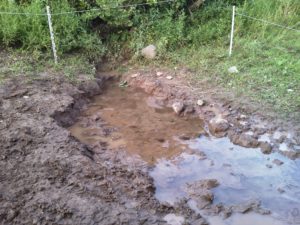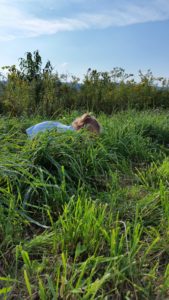Building a Climate Resilient Small Farm
How one farmer has adapted for climate change through soil health, infrastructure, and better decision making.
The Halloween storm dropped over 2.5” of rain on our farm. The first half inch fell in about a half hour increment and put a memorable end to Trick or Treating for our two little ghosts. The next two inches fell in just over an hour sometime in the middle of the night. In the morning, we woke to clear skies and strong winds, but nothing was out of place.

Drainage: Our first summer on the farm we worked really hard to correct drainage, erosion, and cattle crossing issues like the one pictured above. Sarah Ficken / New Moon Farms
We are fairly isolated on our hillside farm and it wasn’t until a friend currently living in the UK messaged us to see how we faired in the storm did we realize what a big deal it was. See, our field road didn’t wash out. And there wasn’t a pile of silt in front of the milk house and the barn didn’t flood. Our fields showed no obvious signs of erosion and the Town guy in his tiny street sweeper wasn’t running back and forth along our road. Our usual indicators of extreme rainfall simply didn’t appear.
I can still remember standing with a shovel in the pouring rain, sweat pants rolled up to my thighs and water pouring in the top of my barn boots. Like a gondolier without a boat I swiped my shovel vigorously at the water moving through a pinch point, trying in vain to keep our barn from flooding. Or there was the storm in 2013 where the water from our gorge carved a new path, taking with it our field and much of our corn and depositing it on top of our neighbor’s pumpkins.
It isn’t that these extreme storms don’t happen anymore, but we have worked diligently to become more resilient and to adopt technology and make decisions that make us more flexible and less vulnerable to extreme weather.

Grass: Being a small family farm means that we accomplish most tasks as a family. Our girls bring joy to daily tasks like checking the grass height in our pastures. Sarah Ficken / New Moon Farms
We weathered the Halloween storm without damage to our buildings or our land because of good luck and a myriad of actions we have taken over the past seven growing seasons. Building our soil health has been key. Switching to no-till planting and adopting a rigorous cover cropping strategy has kept our soil intact and almost eliminated field erosion. Infrastructure improvements, like rerouting our field road or taking advantage of prevailing winds in our barn design, have allowed us to avoid catastrophes and reduce costs. Using the tools on the ClimateSmartFarming.Org website has helped us make better informed decisions about cropping and anticipate problems. Building diversity and redundancy into almost all of our systems has allowed us to survive years that have been extremely dry and extremely wet.
Our baler is parked for the year and our summer projects are either mostly tied up or postponed for next summer. As the days grow shorter, we sit on the couch together at night with a hot cup of tea and we dream. Our conversations meander from the grand to the mundane, but through each we weave the tapestry that is our farm ecosystem. Sometimes we focus on problem solving. How do we deal with that wet spot by the barn? What are we going to do about nearly half our herd freshening in a two-month period next summer? Sometimes our conversations are abstract. How do we align the farm with our values? What are our values? How have they changed in the almost eight years we have been farming together? These conversations help guide us through the long summer sprint. They help us create plans and systems that allow our farm to run smoothly and to be more resilient in the face of climate change. Taken individually, none of our actions have been novel, but together they have helped us build a system of diversity and resilience that allows us to withstand hard years and thrive in good years.

